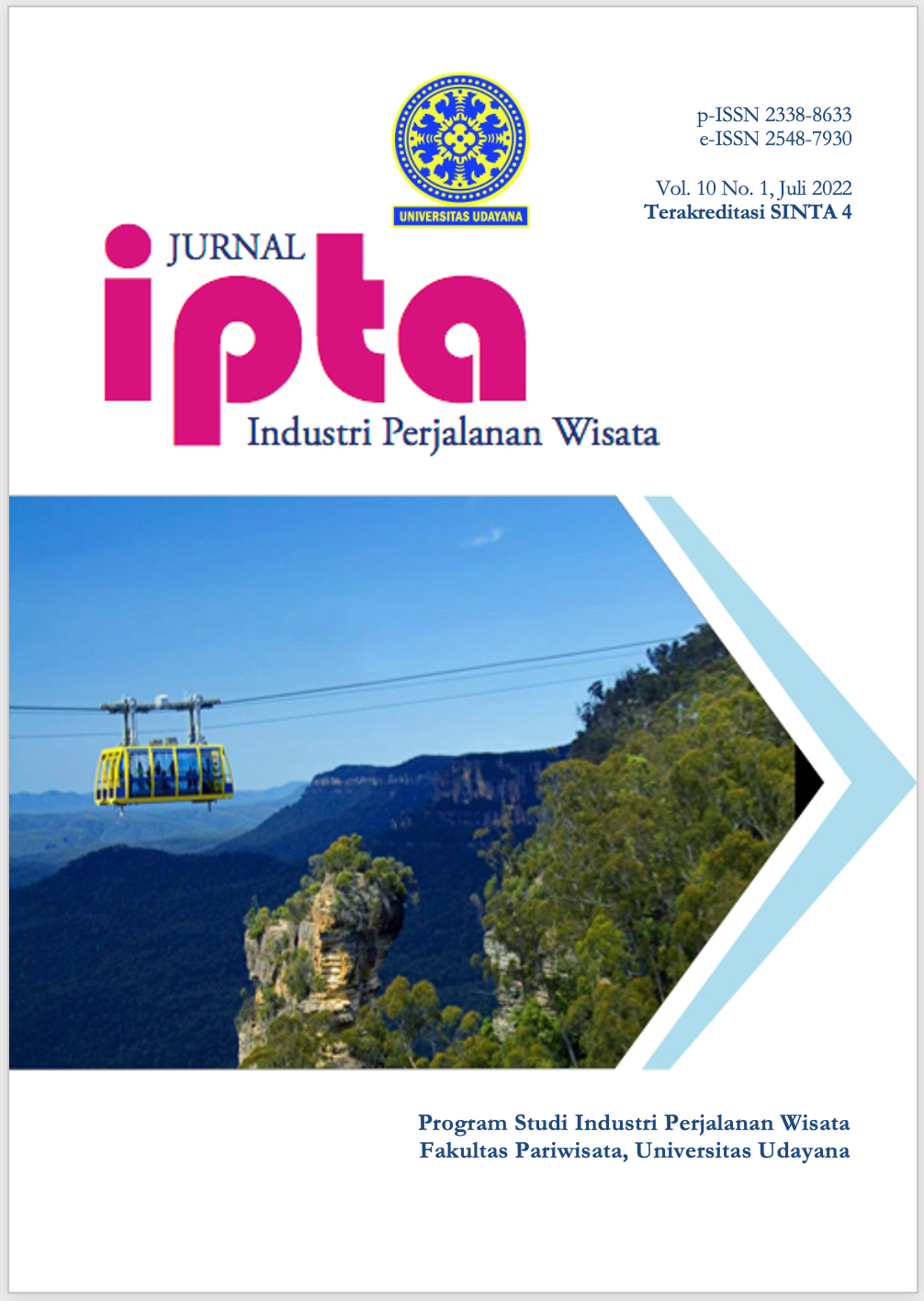FAKTOR YANG MEMPENGARUHI WISATAWAN NUSANTARA KE BALI DI MASA PANDEMI COVID-19
Abstract
The rapid decline of the tourism sector during the pandemic makes this study important, because it can move the Bali tourism sector by knowing the factors that affect the intention of visiting domestic tourists who have visited Bali during the pandemic. So, it will describe what is desired by tourists such as: green zone areas, attractions that have established health protocols, and destinations that still attract tourists. This research was conducted in Bali especially Tanah Lot Special Tourism Attraction, Double Six Seminyak Beach, Ubud Monkey Forest, using 100 tourists’ samples determined according to slovin formula. Researchers used questionnaires distributed to tourists who had visited Bali. Then the data is analyzed using factor analysis with the help of Statistical Package for the Social Sciens Version 21.0. The results of the study are 1) there are seven factors formed in influencing the intention of visiting Indonesian tourists during the pandemic to Bali. These factors include travel risk factors, destination image factors, driving factors, hospitality risk factors, pull factors, destination risk factors and trust factors. 2) the dominant factor that influences the intention to visit Indonesian tourists during the pandemic to Bali is the first factor named travel risk factor. Travel risk factors outperformed other factors with variance percentage of 37,216% and eigenvalue of 13,770. The indicator of forming factors that have the highest loading factor value on travel risk factors is the nature of traveling with a loading factor of 0.777.
Downloads
References
Anonim 2021, Rilis Data Statistik Resmi Bulan Desember Tahun 2020 https://disparda.baliprov.go.id/rilis-data-statistik-resmi-bulan-desember-2020/2021/02/, Diunduh pada tanggal 03 Maret 2021 pukul 10:00 WIB.
Fishbein, M., dan Ajzen, I. 1975, Belief, Attitude, Intention, and Behavior: An Introduction to Theory and Research, Reading, MA: Addison-Wesley.
Ghozali, Imam 2005, Aplikasi Analisis Multivariate Dengan Program SPSS, Semarang: Badan Penerbit Universitas Diponegoro.
Kotler, Philip., dan Amstrong, Gary 1996. Dasar-Dasar Pemasaran. Jakarta: Intermedia.
, Philip and Amstrong, Gary 2012, Metode Penelitian Kualitatif. Bandung: Alfabeta.
Pitana, I Gede., dan Gayatri, Putu Gede 2005. Sosiologi Pariwisata. Yogyakarta: Andi.
Seaton, A.V dan Bennet M. 1996. The Marketing Tourism products: Concepts, Issues and Cases. London: International Thomson Business Press.
Sugiyono 2003. Metode Penelitian. Bandung: Alfabeta.
, 2005. Metode Penelitian Kualitatif. Bandung: Alfabeta.
, 2010. Metode Penelitian Pendidikan Pendekatan Kuantitatif, Kualitatif, dan R&D. Bandung: CV Alfabeta.
, 2013. Metode penelitian Kuantitatif, Kualitatif, dan Kombinasi (Mixed Methods), cetakan ke-3, Bandung: Alfabeta.
Sutrisno 1998. Psikologi Pariwisata. Jakarta: Yayasan Obor Indonesia.
Undang-Undang Republik Indonesia Nomor 10 Tahun 2009 Tentang Kepariwisataan.
Yoeti, O. A. 1996. Pengantar Ilmu Pariwisata. Edisi Revisi. Cetakan Pertama, Bandung: Penerbit Angkasa.
Jurnal:
Alegre, Joaquin., and Magdalena, Cladera 2009, “Emerald European Journal of Marketing. Analyzing The Effect of Satisfaction and Previous Visits on Tourist Intentions to Return”, Vol. 43, Iss 5/6, Hh. 670.
Beerli, A., Martin, J.D 2004, “Factors Influencing Destination Image”, Annals of Tourism Research, Vol. 31, No. 3, Hh. 657 – 681.
Cahyanti, Mega Mirasaputri., dan Anjaningrum, Widiya Dewi 2017, “Meningkatkan Niat Berkunjung Pada Generasi Muda Melalui Citra Destinasi dan Daya Tarik Kampung Wisata”, Jurnal JIBEKA, Vol. 11 No. 1, Hh. 35.
Hidayat, T. T. N., Chalil, & Sutomo, M. 2017. Pengaruh Aksesibilitas dan Citra Destinasi Terhadap Niat Berkunjung Kembali Ke Telaga Tambing. Jurnal Ilmu Manajemen, Vol. 3, No. 2.
Khan, M. Jamal., Chelliah, Shankar., dan Ahmed, Sahrish 2017, “Factors Influence Destination Image and Visit Intention among Young Women Travellers: Role of Travel Motivation, Perceived Risks, and Travel Constraints”, Asia Pacific Journal of Tourism Research, Vol. 22, No. 11, Hh. 1139-1155.
Khairunnisa, Syifa. Nuri 2020, Terbang ke Bali Wajib Tes Swab, Wisatawan Pilih Batalkan Liburan,
https://travel.kompas.com/read/2020/12/16/190500227/terbang-ke-bali-wajib-tes-swab-wisatawan-pilih-batalkan-liburan?page=all Diakses pada tanggal 03 Maret 2021 pukul 10:30 WIB.
Kim, Sung-Bum., Kwon, Ki-Joon 2018, “Examining the Relationships of Image and Attitude on Visit Intention to Korea among Tanzanian College Students: The Moderating Effect of Familiarity”, Journal Suistainability, Vol. 30, No 360. Hh. 1 – 15.
Marco, Valeri., Ahmad, Albattat., Jamaludin, Azizul., Zuraimi, Mohd 2020, “Visit Intention and Destination Image in Post-Covid-19 Crisis Recovery”, Journal: Current Issues in Tourism,
Oliver, R. L. 1980, “A Cognitive Model of The Antecedents and Consequences of Satisfaction Decisions”, Journal Of Marketing Research, Vol. 17, November, Hh. 460 – 469.
Pappas, Nikolaos 2021, “COVID19: Holiday intentions during a pandemic”, Journal Tourism Management, Vol. 84, June 2021, 104287.
Qu, Hailin., Kim, Lisa Hyunjung., dan Im, Holly Hyunjung 2011. A Model of Destination Branding: Intergrating the Concept of the branding and destinaton image. Journal Tourism Management, Vol. 32, No. 3, Hh. 465-476.
Satyarini, Ni Wayan Marsha., Rahmanita, Myrza., Setarnawat, Sakchai 2017, “The Influence of Destination Image on Tourist Intention and Decision to Visit Tourist Destination (A Case Study of Pemuteran Village in Buleleng, Bali, Indonesia)”, TRJ Tourism Research Journal, Vol. 1 No. 1.
Yacob, Syahmardi., Johannes., Qomariyah, Nor 2019, “Visiting Intention: A Perspective of Destination Attractiveness and Image in Indonesia Rural Tourism”, Sriwijaya International Journal Of Dynamic Economics And Business, Vol. 3, No. 2.

This work is licensed under a Creative Commons Attribution-ShareAlike 4.0 International License.





